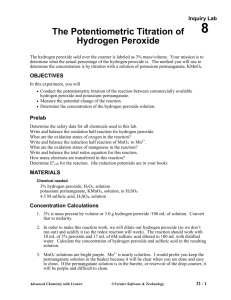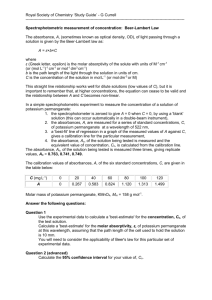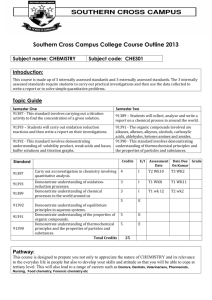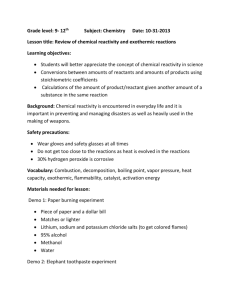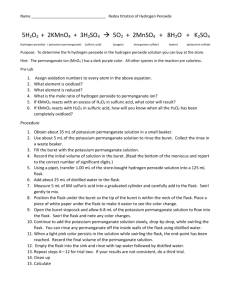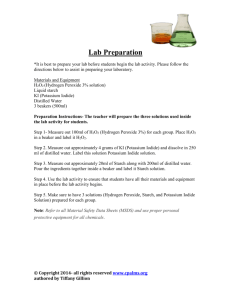Gravimetric analysis of a mixture - BHS Chemistry
advertisement
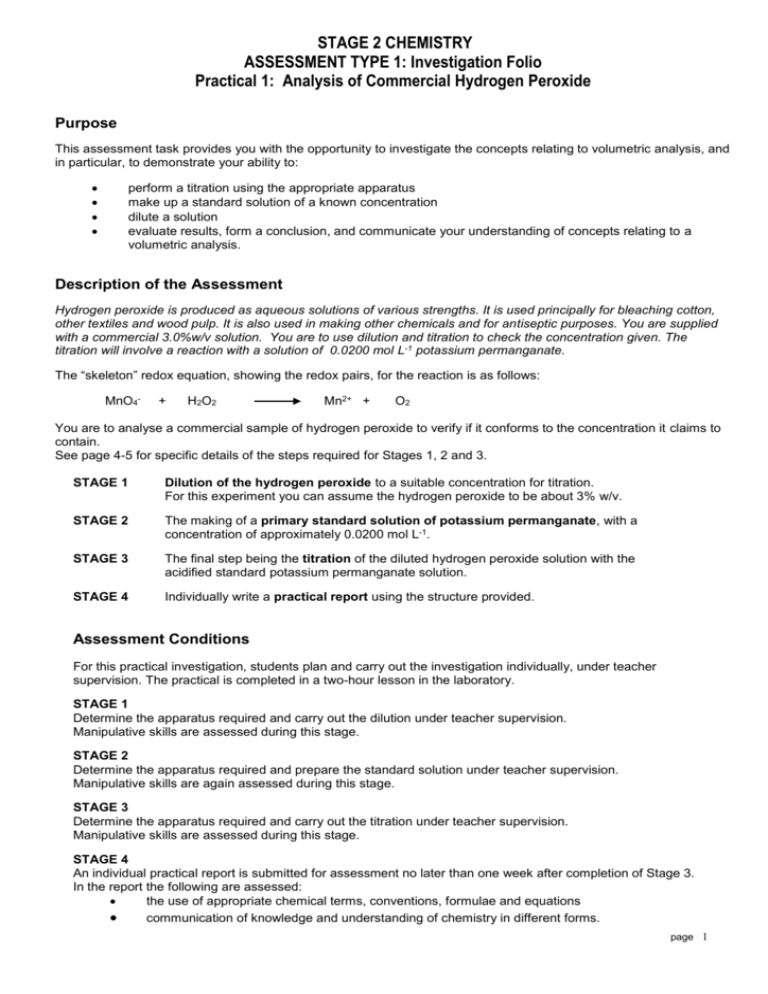
STAGE 2 CHEMISTRY ASSESSMENT TYPE 1: Investigation Folio Practical 1: Analysis of Commercial Hydrogen Peroxide Purpose This assessment task provides you with the opportunity to investigate the concepts relating to volumetric analysis, and in particular, to demonstrate your ability to: perform a titration using the appropriate apparatus make up a standard solution of a known concentration dilute a solution evaluate results, form a conclusion, and communicate your understanding of concepts relating to a volumetric analysis. Description of the Assessment Hydrogen peroxide is produced as aqueous solutions of various strengths. It is used principally for bleaching cotton, other textiles and wood pulp. It is also used in making other chemicals and for antiseptic purposes. You are supplied with a commercial 3.0%w/v solution. You are to use dilution and titration to check the concentration given. The titration will involve a reaction with a solution of 0.0200 mol L-1 potassium permanganate. The “skeleton” redox equation, showing the redox pairs, for the reaction is as follows: MnO4- + H2O2 Mn2+ + O2 You are to analyse a commercial sample of hydrogen peroxide to verify if it conforms to the concentration it claims to contain. See page 4-5 for specific details of the steps required for Stages 1, 2 and 3. STAGE 1 Dilution of the hydrogen peroxide to a suitable concentration for titration. For this experiment you can assume the hydrogen peroxide to be about 3% w/v. STAGE 2 The making of a primary standard solution of potassium permanganate, with a concentration of approximately 0.0200 mol L-1. STAGE 3 The final step being the titration of the diluted hydrogen peroxide solution with the acidified standard potassium permanganate solution. STAGE 4 Individually write a practical report using the structure provided. Assessment Conditions For this practical investigation, students plan and carry out the investigation individually, under teacher supervision. The practical is completed in a two-hour lesson in the laboratory. STAGE 1 Determine the apparatus required and carry out the dilution under teacher supervision. Manipulative skills are assessed during this stage. STAGE 2 Determine the apparatus required and prepare the standard solution under teacher supervision. Manipulative skills are again assessed during this stage. STAGE 3 Determine the apparatus required and carry out the titration under teacher supervision. Manipulative skills are assessed during this stage. STAGE 4 An individual practical report is submitted for assessment no later than one week after completion of Stage 3. In the report the following are assessed: the use of appropriate chemical terms, conventions, formulae and equations communication of knowledge and understanding of chemistry in different forms. page 1 Learning Requirements Assessment Design Criteria 1. demonstrate and apply knowledge and understanding of chemical concepts and interrelationships Investigation The specific features are as follows: I1 Design of chemistry investigations. Communication I2 2. formulate questions, manipulate apparatus, record observations in practical chemical activities, and design and undertake chemistry investigations 3. demonstrate an understanding of how knowledge of chemistry can be used to draw informed conclusions or make informed decisions, taking into account social and environmental contexts 4. develop possible solutions to a variety of problems in chemistry, in new or familiar contexts 5. critically analyse and evaluate chemical information and procedures from different sources 6. communicate in a variety of forms using appropriate chemical terms and conventions. Capabilities Selection and acknowledgment of information about chemistry and issues in chemistry from different sources. I3 Manipulation of apparatus and technological tools using safe and ethical investigation procedures. I4 The obtaining, recording, and display of findings of investigations using appropriate conventions and formats. Citizenship Personal Development Work Learning Analysis and Evaluation The specific features are as follows: AE1 Analysis and evaluation of data and other evidence to formulate conclusions and make relevant predictions. AE2 Evaluation of procedures, with suggestions for improvements. Application The specific features are as follows: A1 Application of chemistry concepts and evidence from investigations to solve problems in new and familiar contexts. A2 Use of appropriate chemistry terms, conventions, formulae, and equations. A3 Demonstration of skills in individual and collaborative work. Knowledge and Understanding The specific features are as follows: KU1 Demonstration of knowledge and understanding of chemistry concepts. KU2 Use of knowledge of chemistry to understand and explain social or environmental issues. KU3 Communication of knowledge and understanding of chemistry in different forms. page 3 Materials: Note: You will be provided with: hydrogen peroxide solution 100 mL conical flasks solid potassium permanganate (KMnO4) burette 2.00 mol L-1 sulfuric acid solution burette funnel a range of volumetric glassware white tile pipette filler retort stand and clamp electronic balance You must complete the record sheet in pen as you carry out the experiment and have it signed when you have completed the experiment. Investigation Folio: Practical – Volumetric Analysis STAGE 1 1 2 Hydrogen peroxide must be diluted by a factor of 1 in 20. Perform the dilution using appropriate glassware. Answer the question on the record sheet before commencing Stage 2. STAGE 2 1 2 Dilution of the hydrogen peroxide The making of a primary standard solution of potassium permanganate Using the electronic balance and appropriate volumetric flask, prepare the standard potassium permanganate solution with concentration of approximately 0.0200 mol L-1. Answer the questions on the record sheet before commencing Stage 3. STAGE 3 Titration of the diluted hydrogen peroxide solution with the standard potassium permanganate solution. 1 Complete the information required on the record sheet before commencing the titration . 2 Pipette a 20.0 mL sample of the diluted H2O2 solution into a conical flask. 3 Add 10.0 mL of dilute sulfuric acid to the conical flask. 4 Fill a burette with the standardized KMnO4 solution. 5 Titrate the H2O2 solution with the KMnO4 until the solution just shows a permanent pink colour. 6 Repeat until three concordant titres are performed. 7 Use your results to determine the concentration of: (1) the diluted hydrogen peroxide in mol L-1 (2) the undiluted solution in mol L-1 and %w/v (g/100mL) 8 Record all of your titration data in the table on the record sheet. 9 Write a report showing your calculations and addressing the criteria given on the mark scheme. page 4 STAGE 4 Use the following report structure: Purpose State the purpose of the investigation clearly. Data Presentation Record the data and any observations in a table(s) using correct significant figures. Data Analysis Include the calculations you made. Explain your results using chemical concepts. Interpretation and Evaluation Answer the following questions. i Describe the rinsing procedure for the pipette and explain why this procedure is necessary to ensure accuracy of the experiment. ii a) b) c) Describe possible sources of random error in this experiment. Explain the likely impact of these errors on the precision of the results. Describe ways to reduce the impact of random errors in an experiment. iii a) Describe possible sources of systematic error in this experiment, being specific in your answer. Explain the likely impact of this error on the accuracy of the results. b) iv State and explain the effect on the titre value if the burette had been rinsed with distilled water immediately before the titration was commenced. Conclusion Write a conclusion that is based on the results and to the purpose of your investigation. NOTE: Your practical report must have the signed record sheet (page 6), attached when submitted for assessment. page 5 STAGE 2 CHEMISTRY ASSESSMENT TYPE 1: Investigation Folio Practical 1: Analysis of Commercial Hydrogen Peroxide RECORD SHEET Student Name: ……………………………………….. STAGE 1: Dilution of the hydrogen peroxide solution Stated concentration on the bottle: ________________________________________________________ Dilution factor: _____________________________________ Volume of pipette used: ______________________________ Volumetric flask size: ________________________________ STAGE 2 The making of a primary standard solution of potassium permanganate Mass of potassium permanganate used ___________________________ Volumetric flask size ___________________________________ Calculation of the concentration of potassium permanganate: STAGE 3 Titration of the diluted hydrogen peroxide solution with the standard potassium permanganate solution. Volume of pipette used __________________ Write a balanced redox equation for the reaction occurring in the conical flask. Titration Number 1 2 3 4 5 final volume (mL) initial volume (mL) Titre (mL) Average titre: Teacher Signature: ……………………………… Date: ……………………… page 6


